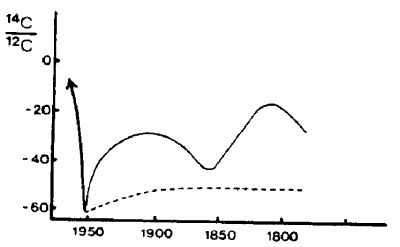Coral Carbon Ratios Confound Chronometry
By measuring the carbon-14/carbon-12 ratios in the annual growth bands of coral, scientists hope to spot natural and man-made changes in global chemistry. For example, the large-scale use of fossil fuels should depress the ratio by adding carbon-12 in undue quanti ties. The advent of the nuclear age boosts the ratio through the addition of carbon-14 to the environment. Predictably, the carbon ratio rises dramatical ly after 1950 (the bomb tests, etc.). Before this date, however, anomalies crop up:
- Coral-ring and tree-ring data differ substantaially when they should not;
- Coral-ring carbon ratios from relatively close locales, such as Bermuda (solid line) and the Florida Keys (dashed line), also differ significantly.
Item 1 might be due to non-atmospheric carbon upwelling in deep-ocean water; but this would not explain the Bermuda and Florida discrepancies.
(Anonymous; "Carbon-14 Variations in Coral," Open Earth, No. 3 p. 30, 1979
Comment. These discrepancies are particularly relevant to the carbon-14 dating of seashells, which often produces wildly incorrect ages.

